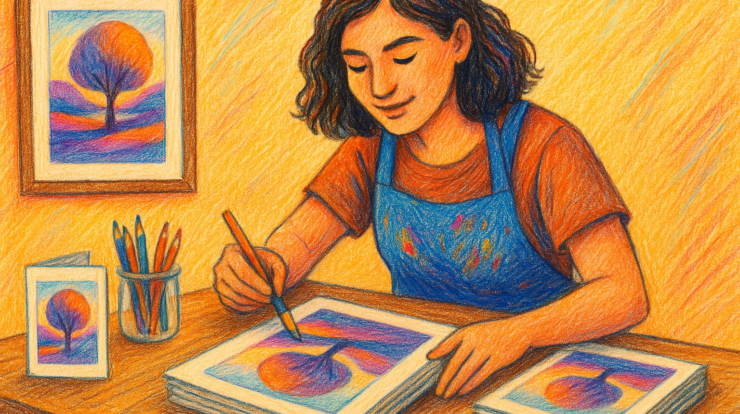
At some point, nearly every artist considers it:
Should I start offering prints, cards, or lower-cost items alongside my original work?
It’s an understandable question, especially after a slow show or in the middle of a stretch where originals aren’t moving. Maybe you’re standing at your booth while other artists sell stacks of prints or racks of cards, and you start wondering whether you’re missing out.
Like many business decisions in the art world, the answer isn’t black and white. But there are some solid guideposts that can help you make the right call for your goals, personality, and business.
Diversification Can Open Doors—If You Treat It Like a Business
Let’s start with the obvious upside: offering prints or small products can expand your audience. Not everyone can afford (or is ready for) a $2,000 original painting. But a $40 print? A $7 greeting card? That’s often an easy yes for someone who connects with your work but isn’t in a position to buy big.
More importantly, these lower-cost items can be the beginning of a collector relationship. A print buyer becomes a newsletter subscriber. A card buyer visits your website. One day, they circle back and buy an original.
But—and this is critical—this only works if you treat it like a business expansion, not a side hobby. That means thinking through production, pricing, inventory, packaging, and branding. It’s easy for product lines to become distractions or money sinks if not carefully managed.
Keep It Simple at the Start
If you’re testing the waters, start with one or two print sizes. Choose a few best-selling or most iconic pieces to reproduce. Use affordable but quality materials. Package them professionally—backing boards and clear sleeves go a long way in presentation—and price them in a way that reflects your brand.
This is not about creating bargain-bin merchandise. You’re still an artist presenting work with value. The format may be smaller or more affordable, but the presentation should communicate care and quality.
You’ll learn quickly what resonates. Some images will sell, others won’t. Over time, you can trim what doesn’t move and expand what does. Think of it as a slow, steady test rather than a sudden shift.
Will Prints Undermine My Originals?
One of the biggest concerns I hear from artists is:
Won’t selling prints cheapen my originals?
It’s a valid question—but in practice, I’ve found the answer is no.
Original buyers and print buyers tend to be two distinct groups. The collector who falls in love with your $4,000 painting isn’t going to be swayed by the fact that you offer $50 prints. If anything, they’ll be pleased that others can enjoy your work in a different way—and they’ll still take pride in owning the one and only original.
In fact, I’ve seen prints help original sales. A buyer sees the print, loves the image, then decides they want the real thing. Or they buy the original and are offered a print to hang in a second home or gift to a friend.
Handled well, prints can support your originals—not compete with them.
Cards, Gifts, and Other Products
Cards, postcards, calendars, and other small items are lower-margin but higher-volume products. If you enjoy the production and fulfillment side of things—and you’re showing in events with a strong “gift-buying” crowd—these can be effective tools.
But again, keep it strategic. Make sure anything you offer aligns with your style, your quality standards, and your long-term brand. It’s easy to start tacking on product after product, and before long, you’ve shifted from fine artist to full-time merchandiser.
That may work for some—but it’s not the right path for everyone.
Ask Yourself These Questions Before You Diversify
If you’re on the fence, take a moment to reflect:
- Am I doing this because I believe it’s a good long-term addition to my business, or because I’m reacting to a slow show?
- Do I have the systems (or the interest) to manage inventory, packaging, and shipping?
- Will these products reflect the same level of quality and professionalism as my originals?
- Do I have a plan to collect buyer information and follow up (email list, website, etc.)?
If you answer yes to most of these, then testing a small product line might be a smart move.
Final Thought
Adding prints or cards isn’t about “selling out” or lowering your standards. It’s about meeting people where they are and creating pathways for connection. If handled thoughtfully, these lower-priced items can become an onramp for future collectors, a bridge to better exposure, and a meaningful source of income.
Just make sure you stay in control of the process—and don’t let the tail wag the dog. You’re still an artist first. Let everything else support that.
Thank you.
Very informative article.
Thank you Jason for addressing this question. I get such mixed feedback from professional artists I know about cards and prints. I think you provided some excellent questions to ask myself, as well as what it means to add this dimension to an art business. I have sold originals and prints. I like having different price points, especially online. P.S. I’m changing my website, so there isn’t much to see right now.